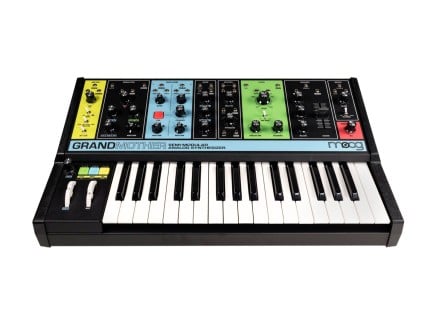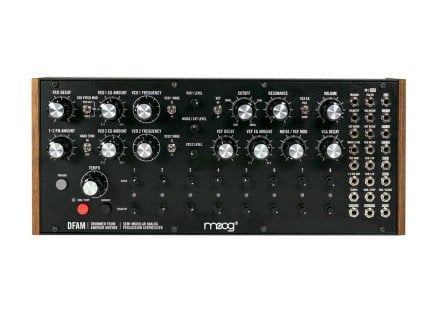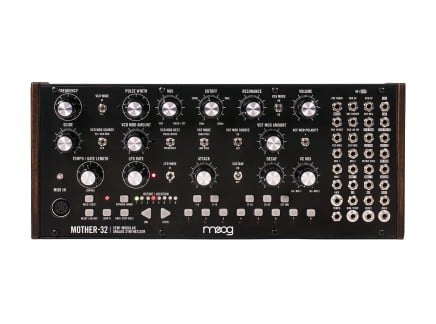Following in the footsteps of the Mother-32 and DFAM, Moog's Subharmonicon is finally available as a ready-to-use, assembled instrument. First revealed as part of the Engineers workshop at Moogfest 2018, the original Subharmonicon is a rare and desirable device...one whose lack of availability has prompted huge forum threads and publicly initiated petitions. So, all you who wrote letters to Moog pleading for its release...your day is here.
And while Mother-32 and DFAM have relatively straightforward (yet still quite fun) approaches to synthesis, Subharmonicon has some interesting and peculiar tricks up its sleeve. With a feature set uncommon in any synth, the Subharmonicon provides complex logic-based interlocking sequences and is great a producing huge, dramatic six-voice chords with only two oscillators...but how is that even possible? Let's take a look at some of Subharmonicon's inner workings, as well as the concepts and devices that inspired it.
What are Subharmonics?
Understanding Subharmonicon first requires an understanding of the harmonic series—a kind of mind-blowing set of natural, physical rules that govern the way we perceive sound. In short, every sound is comprised of several simultaneous tones working together sympathetically—a fundamental frequency, which we often identify as a sound's "pitch," and several overtones whose loudness and tuning relative to the fundamental help define what we perceive as a sound's timbre. In natural sounds, the overtones mostly conform to a specific pattern of frequencies—specifically, whole-number multiples of the fundamental frequency. Each of the overtones is itself a sine wave—and adding all of these sine waves at different frequencies and amplitudes creates more complex waveforms.
So a saw wave, for instance, is comprised of several tones: a fundamental, and then another tone twice the frequency of the fundamental (appearing an octave higher), another three times the frequency (appearing an octave and a fifth higher), another four times the frequency (appearing two octaves higher)...and so on. Let's say your fundamental is 100Hz: overtones will occur at 200Hz, 300Hz, 400Hz, 500Hz, etc. upward into infinity. (Oh by the way—if you play a brass instrument, the harmonic series should be pretty familiar to you—each successively higher partial on your instrument conforms to this series as well!)
Subtle detuning of these frequencies and changes in their individual loudness is what gives every sound its characteristic color. To dig deeper into this topic, check out this recent video by popular producer/synthesist Andrew Huang, which covers these concepts in his patently animated style.
Okay, cool—so sounds are comprised of a fundamental pitch and overtones that conform to the harmonic series. But there's a weird world on the other side of the spectrum...the subharmonic series. If you think of the harmonic series as a set of frequencies derived by multiplying a fundamental frequency by whole numbers, the subharmonic series is derived by dividing by whole numbers. So a starting pitch of 1000Hz, for instance, could yield subharmonics at 500Hz, 250Hz, 125Hz, 62.5Hz, etc. However, the subharmonic series does not occur naturally—and in order to generate subharmonics from a static tone, you need some form of electronic intervention.
But why would you want to use subharmonics in your music? Well, as it turns out, using a set of pitches derived by dividing a specific static frequency by whole numbers sounds dang good. It creates interesting sub intervals, which within the span of four octaves create something like an altered minor scale. Because of the way these frequencies slot into place, it's very easy to use the subharmonic series to create colorful melodies and harmonies by only varying which subharmonics are heard—and in fact, this has been used as the basis for plenty of interesting music throughout the years (check out David Rosenboom's In the Beginning I, for instance, in which a Buchla 300 system was programmed to produce both polyrhythms and harmonies derived from the subharmonic series).
So what is Subharmonicon?
Moog's Subharmonicon was designed to take advantage of these very concepts. It was inspired by Friedrich Trautwein's Trautonium, an early analog electronic instrument which utilized saw waves tuned to subharmonics of a common tone in order to create complex timbres and harmonies. It is equally inspired by the Rhythmicon, a device created by electronic music pioneer Leon Theremin to create rhythmic patterns using the same logic as the subharmonic series: by dividing a specific "clock" rate by whole numbers, he could create complex polyrhythms based on this series. (For more about the rhythmicon, check out our article about early Soviet electronic instruments here.)
The Subharmonicon has two analog oscillators, each with two tunable subharmonic generators. These oscillators and their two subharmonics can be mixed together and sent into a common Moog ladder filter and VCA. By tuning both oscillators to the same pitch, you could generate four subharmonics based on that pitch to create a huge, thick harmony...or, by tuning the oscillators to different pitches, you could pick out groups of subharmonics from each that work well together. This is a novel approach to thinking about harmony, and often leads to pleasantly unpredictable results. The new version of the Subharmonicon even includes selection for quantization in multiple tuning systems, making it easy to get the most out of these otherworldly harmonies. Experiment with just intonation, switch to traditional equal temperament, or stick to straight, intuitive unquantized mode.
Of course, creating these bizarre harmonies is only part of the fun: Subharmonicon also employs some of the rhythmic spirit behind the Rhythmicon in its dual sequencer. The sequencer section is comprised of multiple parts: two four-step sequencers and four "rhythm" generators, collectively called the "polyrhythm" section. The polyrhythm section is a set of clock dividers all synced to a master tempo—and by turning their knobs, you select the subdivision rate from 1 to 16 (just like the control for the sub frequencies on the oscillators...mind=blown). Buttons below each of the Rhythm knobs determine which sequencer(s) the Rhythm in question is sent to—and best of all, you can use multiple rhythms to drive either or both sequencers. So despite the fact the sequencers are only four steps each, you could create quite complex polyrhythms that step through those four values with a peculiar rhythmic swagger. You could make it such that the two sequencers are more or less related to one another by syncing them to some combination of common "rhythms," or could keep them only vaguely related by controlling them from completely separate rhythm generators. And the sequencers themselves can be internally connected to their respective oscillators in a few ways—they can directly control the oscillator frequency or sub oscillator divisions...making it easy to create complex, cascading changes in harmonic structure in a variety of ways.
And of course, like the DFAM and Mother-32, Subharmonicon features an open-ended patch bay. And while it's set up so that it can do quite a lot without needing to break out patch cables, it becomes considerably more complex once you start to unlock its modulation capabilities: use sequencers to re-program their own driving rhythms, use the sub oscillators to modulate filter frequency—or interconnect with your other modular or semi-modular gear for a wide variety of new sonic options.
Subharmonicon is a pleasant change of pace after the Mother-32 and DFAM: while they are definitely awesome synths, it's great seeing Moog take on a product with a much more esoteric set of principles behind it. No doubt it will play great with its Moog siblings—but we also expect it to find a home in countless Eurorack and desktop-format setups. Capable of being controlled by both CV and MIDI, the Subharmonicon is a tremendously flexible device for most any type of workflow.
Whether you're looking for an easy way to create lush analog chords, or simply aiming to find a means of experimenting with rhythm and harmony, the Subharmonicon just might be up your alley.











